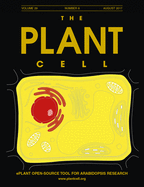
Cover image

Waese et al. (pages
Volume 29, Issue 8, August 2017
IN BRIEF
An Emerging Model Diatom to Study Nitrogen Metabolism
So Much Data, So Little Time: ePlant Steps into the Breach for Plant Researchers
A Genome-Wide Approach to Understanding a Noncanonical ARF
LETTERS TO THE EDITOR
The BIF Domain in Plant bHLH Proteins Is an ACT-Like Domain
Reply: The BIF Domain Is Structurally and Functionally Distinct from Other Types of ACT-Like Domains
LARGE-SCALE BIOLOGY ARTICLES
ePlant: Visualizing and Exploring Multiple Levels of Data for Hypothesis Generation in Plant Biology
ePlant for hypothesis generation permits the exploration of plant data across >12 orders of magnitude encompassing >20 different kinds of genome-wide data, all in one easy-to-use, open-source tool.
Differences in DNA Binding Specificity of Floral Homeotic Protein Complexes Predict Organ-Specific Target Genes
DNA binding specificity of floral MADS domain protein complexes depends on protein complex composition and provides clues to the mechanisms underlying target gene specificity.
Rapid Recovery Gene Downregulation during Excess-Light Stress and Recovery in Arabidopsis
Abiotic stress and recovery transcriptomes reveal extremely short RNA half-lives, changes to cotranslational decay, and recovery-specific networks, consistent with active recovery and cellular memory.
RESEARCH ARTICLES
Auxin-Induced Modulation of ETTIN Activity Orchestrates Gene Expression in Arabidopsis
ETTIN translates changes in auxin levels into diverse transcriptional outcomes to control specific processes during Arabidopsis plant development.
MYC2 Orchestrates a Hierarchical Transcriptional Cascade That Regulates Jasmonate-Mediated Plant Immunity in Tomato
The tomato transcription factor (TF) MYC2 and MYC2-targeted TFs form a hierarchical transcriptional cascade during jasmonate-mediated plant immunity that initiates and amplifies the transcriptional output.
SG2-Type R2R3-MYB Transcription Factor MYB15 Controls Defense-Induced Lignification and Basal Immunity in Arabidopsis
SG2-type R2R3-MYB transcription factor MYB15 regulates preformed and inducible Arabidopsis defense through the production of antimicrobial coumarin scopoletin and G-rich lignin, respectively.
VPS9a Activates the Rab5 GTPase ARA7 to Confer Distinct Pre- and Postinvasive Plant Innate Immunity
Plants utilize conserved and developmentally essential activation of Rab5 GTPases for organizing endomembrane trafficking required for pre- and postinvasive innate immunity
Differentially Regulated Orthologs in Sorghum and the Subgenomes of Maize
The response of the same genes to cold stress often varies between maize and sorghum, but the set of genes with conserved patterns of regulation show greater evidence of functional constraint.
Mutations in eIF5B Confer Thermosensitive and Pleiotropic Phenotypes via Translation Defects in Arabidopsis thaliana
Mutants in the translation initiation factor eIF5B reveal the importance of translation for recovery from heat stress and a possible role for this conserved factor in mRNA-specific translation.
HISTONE DEACETYLASE6 Acts in Concert with Histone Methyltransferases SUVH4, SUVH5, and SUVH6 to Regulate Transposon Silencing
The histone deacetylase HDA6 interacts with the histone H3K9 methyltransferases SUVH4/5/6 to coordinately regulate transposon silencing.
The Arabidopsis LAZY1 Family Plays a Key Role in Gravity Signaling within Statocytes and in Branch Angle Control of Roots and Shoots
The LAZY1 family expressed in statocytes is likely to regulate the polar auxin transport in response to gravistimulation in gravitropism of roots and shoots and in GSA control of lateral roots.
Exploiting Natural Variation to Uncover an Alkene Biosynthetic Enzyme in Poplar
A ketoacyl CoA synthase (PotriKCS1) is key to the biosynthesis of alkenes in the cuticular waxes of poplar leaves.
NRT1.5/NPF7.3 Functions as a Proton-Coupled H+/K+ Antiporter for K+ Loading into the Xylem in Arabidopsis
As a proton-coupled H+/K+ antiporter, NRT1.5/NPF7.3 mediates K+ release from root parenchyma cells into the xylem and coordinates K+/NO3 − distribution in Arabidopsis.
Suppressing a Putative Sterol Carrier Gene Reduces Plasmodesmal Permeability and Activates Sucrose Transporter Genes during Cotton Fiber Elongation
Suppressing the expression of the putative sterol carrier protein gene GhSCP2D in cotton fibers leads to enhanced callose deposition, thereby reducing plasmodesmata permeability and fiber elongation.
Nitrate Reductase Knockout Uncouples Nitrate Transport from Nitrate Assimilation and Drives Repartitioning of Carbon Flux in a Model Pennate Diatom
Genetic inactivation of diatom nitrate reductase abolishes nitrate assimilation but not nitrate uptake and results in transcriptional activation of nitrate storage and triacylglycerol biosynthesis pathways.


